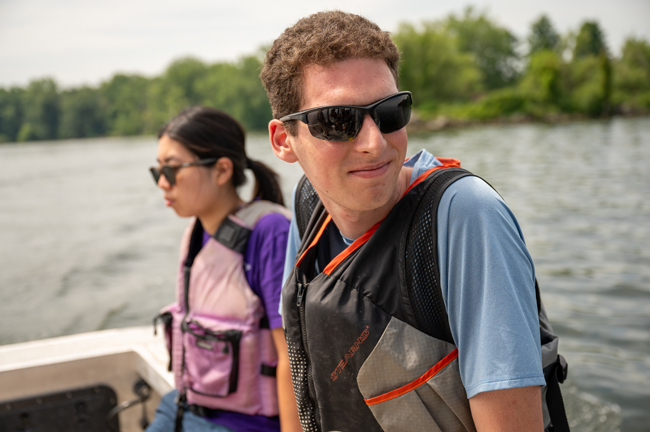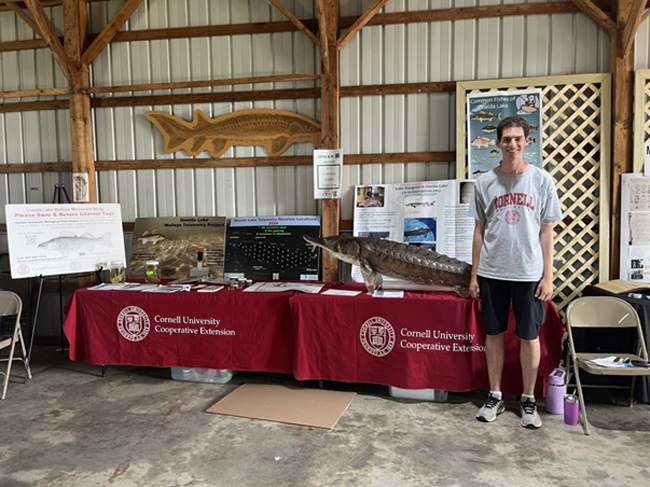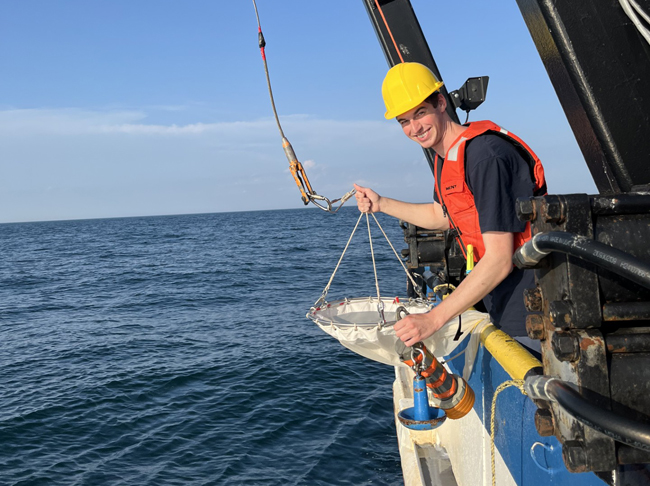
Cornell University student and CCE summer intern James Hoehner (in forefront) aboard a research vessel on Oneida Lake at the Cornell Biological Field Station. Credit: R.J. Anderson/Cornell Cooperative Extension
— By Kara Lynn Dunn, Great Lakes Publicist, New York Sea Grant
Contacts:
Kathy Bunting-Howarth, NYSG's Associate Director, P: 607-255-2832, E: keb264@cornell.edu
Stacy Furgal, NYSG Great Lakes Fisheries and Ecosystem Health Specialist, P: 315-882-6227, E: slf85@cornell.edu
Kara Lynn Dunn, New York Sea Grant Great Lakes Publicist, P: 315-465-7578, E: karalynn@gisco.net
Dr. James Watkins, Cornell Biological Field Station at Shackelton Point Associate Director, P: 315-378-8115, E: jmw237@cornell.edu
Tess Southern, Madison County CCE 4-H Team Leader, P: 315-684-3001 x110, E: tas264@cornell.edu
Morrisville, NY, November 7, 2024 - Through mentoring by New York Sea Grant, the Cornell Biological Field Station (CBFS) at Shackelton Point, and Cornell Cooperative Extension of Madison County, Cornell University junior James Hoehner developed public outreach to highlight the environmental resources of Madison County and New York State.
Interested in careers that combine the environment, science, research, and communication, James was tasked with developing extension and outreach materials related to aquatic and ecosystem research across New York State. To do that, James dove into opportunities to conduct research, interview researchers, take photographs, and develop educational outreach programming.
His summer internship began with a week living and working aboard the Environmental Protection Agency Great Lakes Research Vessel Lake Guardian on Lake Erie. On board, James helped with zooplankton netting, tucker trawling for larval fish, and ponar grab sampling for mussels and benthic invertebrates.

Cornell University student and CCE summer intern James Hoehner (at left) and NYSG Great Lakes Fisheries and Ecosystem Health Specialist Stacy Furgal (at right) at the Cornell Biological Field Station. Credit: R.J. Anderson/Cornell Cooperative Extension
New York Sea Grant Great Lakes Fisheries and Ecosystem Health Specialist Stacy Furgal was one of James’ professional and faculty mentors.
“James’ experience aboard the Lake Guardian included collecting samples that are analyzed to contribute data to the bi-national Cooperative Science and Monitoring Initiative for the Great Lakes. New York Sea Grant and many local, state, federal, and conservation partners use that data to better understand the many features and functions of the Great Lakes’ ecosystem,” said Furgal.
On Oneida Lake with CBFS researchers, James participated in aquatic and avian research. He traveled to research facilities in the state, a fish hatchery, and environmental areas of interest from NY’s Great Lakes to the Adirondack Mountains. James assisted research efforts related to lake sturgeon, common terns, ospreys, zebra and quagga mussels, mayflies, and invertebrates.
CBFS Associate Director James Watkins was among James’ mentors. Watkins notes, “The goal of internships at Shackelton Point is to provide students with hands-on learning across a broad spectrum of Oneida Lake fisheries and aquatic ecosystem science. In the process, they develop skills to translate and communicate research, including their own projects, to the public to encourage good stewardship of our natural resources.”
“Getting out on the water helped with creating extension materials because I interacted directly with scientists in their research, learned its importance, and experienced it firsthand,” James says.

Cornell University student and CCE summer intern James Hoehner at the aquatic environment information booth he helped developed for the 2024 Madison County Fair. Credit: Madison County Cornell Cooperative Extension
With attention to how the materials he developed could be used as Environmental Sciences activities for 4-H youth, James created an educational exhibit for the 2024 Madison County Fair. He also worked with Madison County Cornell Cooperative Extension (CCE) staff to develop games and activities for an aquatic ecology open house for youth hosted at the CBFS.
CCE Madison County 4-H Team Leader Tess Sothern commends the work that James did. “James brought a wealth of information about Oneida Lake and the Cornell Biological Field Station to the Madison County Fair in July, even showcasing a large sturgeon sculpture for attendees. His extensive knowledge sparked incredible conversations, revealing to many just how valuable the lake resource is in our county. Additionally, James coordinated a 4-H Open House at the field station, covering topics from local fish and creatures to the science of plankton, while offering personal tours and seining opportunities. CCE Madison looks forward to more collaborative programming in the future, thanks to James’ connections,” said CCE Madison County 4-H Team Leader Tess Sothern.
While at CBFS, James also assisted tours of the field station for visitors that included aquatic invasive species researchers from Brooklyn, New York State Department of Environmental Conservation leaders, and 4-H educators from across New York State.
“The collaborative nature of my project greatly developed my skills in both research and extension, which has allowed me to grow as a scientist. I have learned that extension is important to scientists as well as members of the public, and that both parties can learn from each other. I will be sure to emphasize extension efforts in future research I do,” says James.
Through all his internship experiences, James learned about diverse ecosystems and species, created informational programming, and communicated his enthusiasm for New York’s varied environments through a 10-week blog and ArcGIS StoryMap highlighting ten research projects conducted by other CBFS interns. The blog is online via Cornell Cooperative Extension.
New York Sea Grant, the Cornell Biological Field Station, and Cornell Cooperative Extension of Madison County offer various student learning opportunities.

Cornell University student and CCE summer intern James Hoehner, aboard a research vessel on Oneida Lake at the Cornell Biological Field Station, deploys a ponar grab, a device used to collect sediment samples from hard bottoms in fresh and saltwater environments. Credit: R.J. Anderson/Cornell Cooperative Extension
More Info: James Hoehner — In His Own Words
This summer I worked with New York Sea Grant in partnership with Madison County Cornell Cooperative Extension and the Cornell Biological Field Station on Oneida Lake (CBFS) to communicate and generate public interest in the exciting and varied research being led by scientists at CBFS.
Throughout the summer, I spent a lot of time participating in field work. I liked getting to see a wide variety of organisms including fish, birds, and invertebrates of all sizes. Getting out on the water like this helped with creating extension materials because I got to hear directly from scientists about the research they are working on and experience it firsthand.

Cornell University student and CCE summer intern James Hoehner deploys a zooplankton net from aboard the EPA Research Vessel Lake Guardian on Lake Erie. Credit: Cornell Biological Field Station
My favorite field work experience was getting to spend a week on Lake Erie aboard the U.S. Environmental Protection Agency’s (EPA) large research vessel the R/V Lake Guardian. Research was being conducted as a part of the 2024 Cooperative Science and Monitoring Initiative (CSMI) field year for Lake Erie. I helped with a variety of surveys including zooplankton netting, tucker trawling for larval fish, and ponar grabbing for mussels and benthic invertebrates. It was a great opportunity for me to experience life at sea, and I enjoyed learning from the other scientists and crew I was living with. My time on the R/V Lake Guardian also gave me the chance to demonstrate the work CBFS does on the Great Lakes, as some people are unaware that CBFS does research on lakes beyond Oneida Lake.
Once I collected content from my experiences in the field, I presented it in a variety of ways to engage many different people. This included social media posts, a weekly blog, and an ArcGIS Story Map that highlighted ten projects by other CBFS interns this summer. My goal was for these extension materials to be informative yet accessible so that all could appreciate them.
I also helped organize a few events this summer. I presented at a booth at the Madison County Fair which allowed me to bring science directly into the community. The fair also gave people a chance to ask me questions and give their observations of the lake ecosystem. In addition to the fair, I also put together a youth open house at CBFS where kids from around the area spent a day learning about aquatic ecology and biology through games and activities I prepared.
Working alongside Sea Grant has been a great experience. The collaborative nature of my project greatly developed my skills in both research and extension which has allowed me to grow as a scientist. I have learned that extension is important to scientists as well as members of the public, and that both parties can learn from each other. I will be sure to emphasize extension efforts in future research I do.
— James Hoehner, a junior at Cornell University, was a Summer 2024 intern through the Cornell Cooperative Extension Internship Program, where he was co-mentored by NYSG’s Stacy Furgal, Jim Watkins (Cornell Biological Field Station at Shackelton Point), and Madison County Cornell Cooperative Extension.

Cornell University student and CCE summer intern James Hoehner prepares to return a lake sturgeon back into Oneida Lake after a data collection effort on the lake with Cornell researchers. Credit: Cornell Biological Field Station
As James mentioned above, he documented his experience as a fellow via a 10-week summer internship experience blog:
Week 1: Onboard the Lake Guardian
Week 2: History and activities at CBFS at Shackelton Point
Week 3: Tern research, assisting researchers from Brooklyn with round goby sampling
Week 4: Planning an exhibit for the Madison County Fair, educating 30 4-H educators from across NY at CBFS Youth Nature and Outdoor Environment program workshop, visiting Lake USGS Lake Ontario Biological Station in Oswego and Lake Neatahwanta in Fulton
Week 5: Gill netting on Oneida Lake for lake sturgeon
Week 6: Ospreys and mysids
Week 7: Engaging Madison County Fair goers
Week 8: The Adirondacks & Cornell’s Little Moose Field Station, trout research, tern update
Week 9: Shackelton Point Youth Open House with Madison County 4-H
Week 10: ArcGIS StoryMapping of 10 CBFS interns research projects
More Info: New York Sea Grant
Established in 1966, the National Oceanic and Atmospheric Administration (NOAA)’s National Sea Grant College Program promotes the informed stewardship of coastal resources in 34 joint federal/state university-based programs in every U.S. coastal state (marine and Great Lakes) and Puerto Rico. The Sea Grant model has also inspired similar projects in the Pacific region, Korea and Indonesia.
Since 1971, New York Sea Grant (NYSG) has represented a statewide network of integrated research, education and extension services promoting coastal community economic vitality, environmental sustainability and citizen awareness and understanding about the State’s marine and Great Lakes resources.
NYSG historically leverages on average a 3 to 6-fold return on each invested federal dollar, annually. We benefit from this, as these resources are invested in Sea Grant staff and their work in communities right here in New York.
Through NYSG’s efforts, the combined talents of university scientists and extension specialists help develop and transfer science-based information to many coastal user groups—businesses and industries, federal, state and local government decision-makers and agency managers, educators, the media and the interested public.
New York Sea Grant, one of the largest of the state Sea Grant programs, is a cooperative program of the State University of New York (SUNY) and Cornell University. The program maintains Great Lakes offices at Cornell University, SUNY Buffalo, Rochester Institute of Technology, SUNY Oswego, the Wayne County Cooperative Extension office in Newark, and in Watertown. In the State's marine waters, NYSG has offices at Stony Brook University and with Cornell Cooperative Extension of Nassau County on Long Island, in Queens, at Brooklyn College, with Cornell Cooperative Extension in NYC, in Bronx, with Cornell Cooperative Extension of Ulster County in Kingston, and with Cornell Cooperative Extension of Westchester County in Elmsford.
For updates on Sea Grant activities: www.nyseagrant.org, follow us on social media (Facebook, Twitter/X, Instagram, Bluesky, LinkedIn, and YouTube). NYSG offers a free e-list sign up via www.nyseagrant.org/nycoastlines for its flagship publication, NY Coastlines/Currents, which it publishes 2-3 times a year.